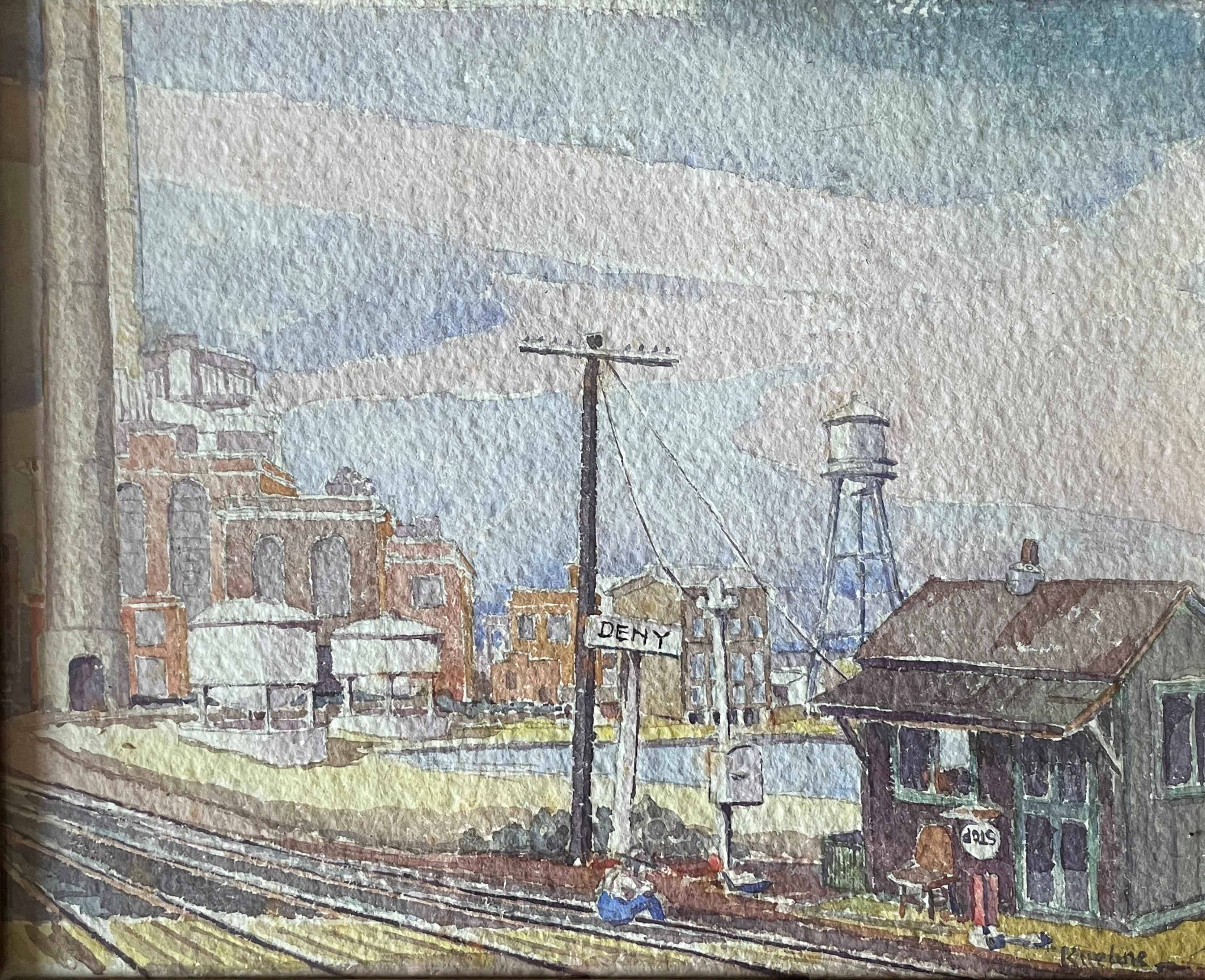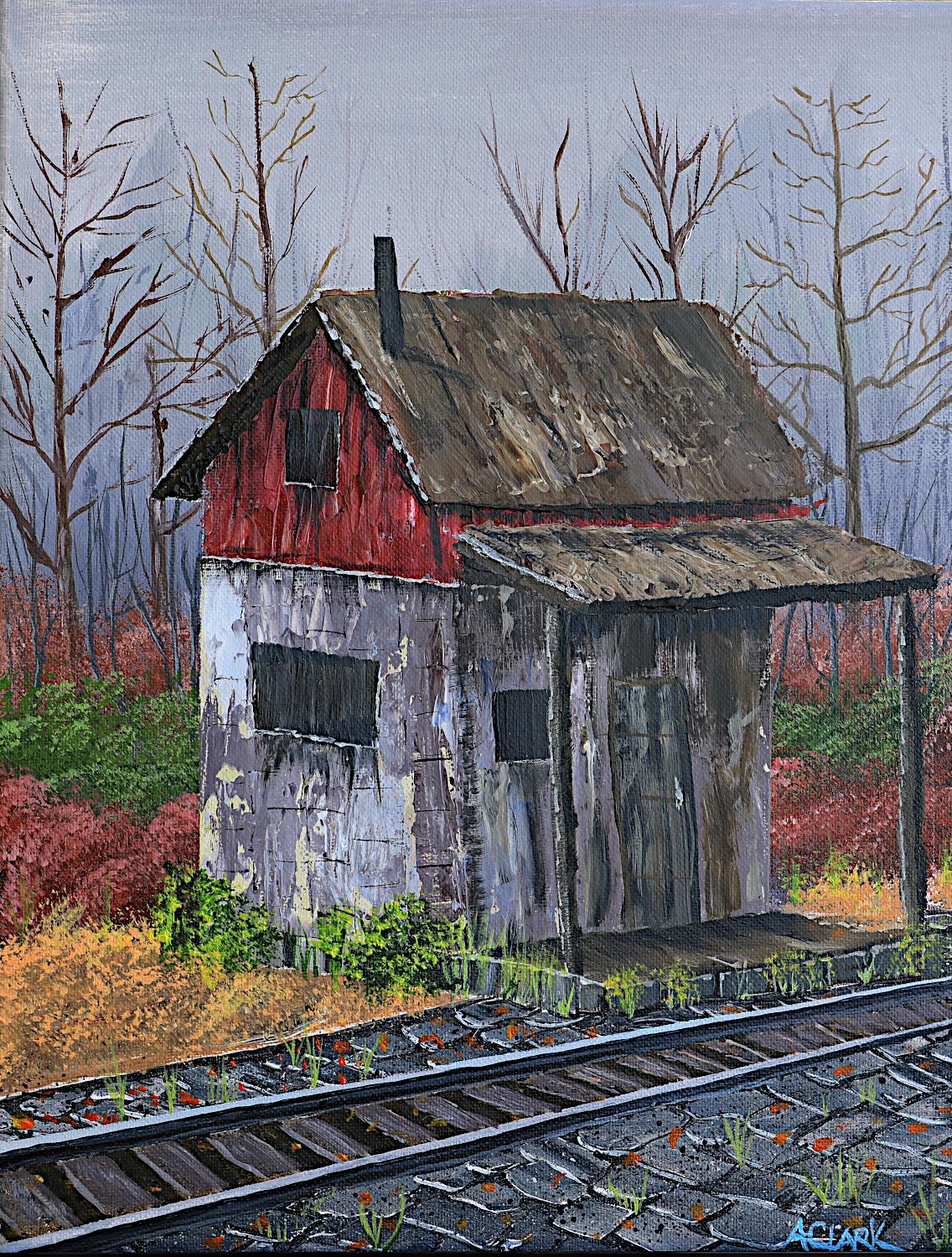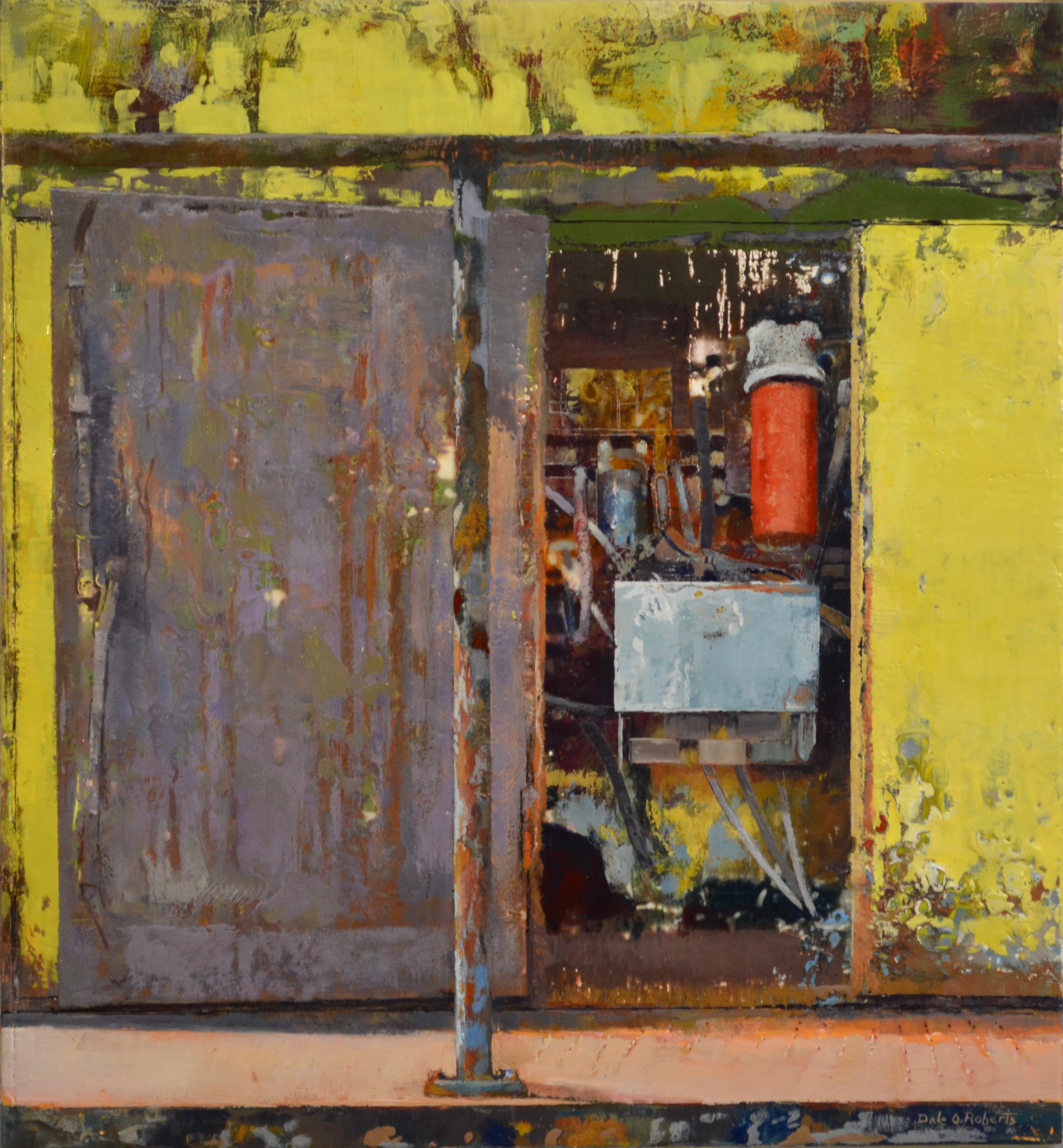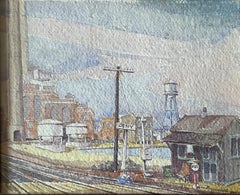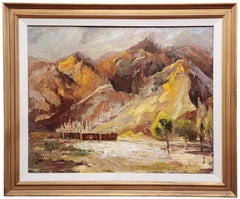Items Similar to The Abandoned Train Car
Want more images or videos?
Request additional images or videos from the seller
1 of 9
Dan (Daniel Stookey) LutzThe Abandoned Train Carc.1960
c.1960
$1,150
£876.12
€1,010.21
CA$1,609.40
A$1,798.24
CHF 940.68
MX$22,052.17
NOK 12,020.08
SEK 11,398.22
DKK 7,539.71
Shipping
Retrieving quote...The 1stDibs Promise:
Authenticity Guarantee,
Money-Back Guarantee,
24-Hour Cancellation
About the Item
This artwork "The Abandoned Train Car" c. 1960 is a watercolor on paper by noted Californian artist Dan (Daniel Stookey) Lutz, 1906-1978. It is signed at the lower right corner. The artwork size is 14 x 20.75 inches, framed size is 27.35 x 33.5 inches. Custom framed in a wooden gold frame, with off white matting and gold color spacer. It is in excellent condition.
About the artist:
Daniel Stookey Lutz was born in Decatur, Illinois on July 7, 1906 to Florence Stookey and Samuel Milton Lutz, who owned a music store in Decatur. His father was a noted violinist and his mother a fine watercolorist and occasional painter. He came of age in the 20s but he matured, as the country did, under the pressures of the Great Depression. He was twenty-three when the stock market fell in the fall of 1929. Fortunately for Lutz, he had already commenced his studies at Art Institute of Chicago (AIC) when the panic of Black Thursday occurred.
After four years of studies at the AIC, Dan Lutz received the James Nelson Raymond Traveling Fellowship in 1931. This allowed the young artist a full year of travel in Europe, primarily in France. Very few, if any, paintings have survived from either his student days or from this early European travel. In the fall of 1932 Lutz returned to Chicago where he married Dorothy Best, with whom he would spend the rest of his life. Later that year Lutz came to Los Angeles, California. He finished his formal training at the University of Southern California (USC) and received a Bachelor in Fine Arts degree.
For the next forty years Lutz would make his way in life as an artist. His work received national recognition and he was beginning to be noticed in Europe when he suffered a stroke and was forced to retire. He had numerous one-person exhibitions, received awards and was recognized as one of California’s leading artist in the artistic community.
- Creator:Dan (Daniel Stookey) Lutz (1906 - 1978, American)
- Creation Year:c.1960
- Dimensions:Height: 27.35 in (69.47 cm)Width: 33.5 in (85.09 cm)Depth: 0.75 in (1.91 cm)
- Medium:
- Movement & Style:
- Period:
- Condition:
- Gallery Location:San Francisco, CA
- Reference Number:Seller: lut/tra/car/011stDibs: LU66638127952
About the Seller
5.0
Platinum Seller
Premium sellers with a 4.7+ rating and 24-hour response times
Established in 1999
1stDibs seller since 2017
808 sales on 1stDibs
Typical response time: 1 hour
- ShippingRetrieving quote...Shipping from: San Francisco, CA
- Return Policy
Authenticity Guarantee
In the unlikely event there’s an issue with an item’s authenticity, contact us within 1 year for a full refund. DetailsMoney-Back Guarantee
If your item is not as described, is damaged in transit, or does not arrive, contact us within 7 days for a full refund. Details24-Hour Cancellation
You have a 24-hour grace period in which to reconsider your purchase, with no questions asked.Vetted Professional Sellers
Our world-class sellers must adhere to strict standards for service and quality, maintaining the integrity of our listings.Price-Match Guarantee
If you find that a seller listed the same item for a lower price elsewhere, we’ll match it.Trusted Global Delivery
Our best-in-class carrier network provides specialized shipping options worldwide, including custom delivery.More From This Seller
View All"The Old Carriage" Large watercolor
Located in San Francisco, CA
This artwork "The Old Carriage" c.1950 is a watercolor on paper by noted California artist William Jack Laycox, 1921-1984. It is signed at he lower right corner by the artist. The ar...
Category
Mid-20th Century American Impressionist Landscape Drawings and Watercolors
Materials
Watercolor
"The Abandoned Farm" Large watercolor.
Located in San Francisco, CA
This artwork titled "The abandoned Farm" c.1960 is a large watercolor on paper by noted California artist William Jack Laycox, 1921-1984. It is signe...
Category
Mid-20th Century American Impressionist Landscape Drawings and Watercolors
Materials
Watercolor
On the Road
By Henry Waltermar Doane
Located in San Francisco, CA
This artwork "On the Road" is a watercolor on paper by noted California artist Henry Waltermar Doane, 1905-2002. It is signed by the artist at the lower ri...
Category
Mid-20th Century American Impressionist Landscape Drawings and Watercolors
Materials
Watercolor
The Old Trestle, San Rafael, California
By Arnold A. Grossman
Located in San Francisco, CA
This artwork titled "The Old Trestle, San Rafael, California" 1986 is a watercolor on paper by noted California artist Arnold A. Grossman, 1923-2016. It is ...
Category
Late 20th Century American Impressionist Landscape Drawings and Watercolors
Materials
Watercolor
Truckee Rail Yard II
Located in San Francisco, CA
This artwork titled "Truckee Rail Yard II" 2015, is an oil painting on canvas by noted American artist Andrew (Andy) Skaff, b.1945. It is signed at the lower right corner by the arti...
Category
21st Century and Contemporary American Impressionist Landscape Paintings
Materials
Oil
The Old Factory
By Arnold A. Grossman
Located in San Francisco, CA
Artist: Arnold Grossman (American, 1923-2016)
Title: The Old Factory
Year: c.1980
Medium: Watercolor
Paper: Watercolor paper
Size image: 16 x 21 in...
Category
Late 20th Century American Impressionist Landscape Drawings and Watercolors
Materials
Watercolor
You May Also Like
"Train Station, " Max Kuehne, Industrial City Scene, American Impressionism
By Max Kuehne
Located in New York, NY
Max Kuehne (1880 - 1968)
Train Station, circa 1910
Watercolor on paper
8 1/4 x 10 1/4 inches
Signed lower right
Provenance:
Private Collection, Illinois
Max Kuehne was born in Halle, Germany on November 7, 1880. During his adolescence the family immigrated to America and settled in Flushing, New York. As a young man, Max was active in rowing events, bicycle racing, swimming and sailing. After experimenting with various occupations, Kuehne decided to study art, which led him to William Merritt Chase's famous school in New York; he was trained by Chase himself, then by Kenneth Hayes Miller. Chase was at the peak of his career, and his portraits were especially in demand. Kuehne would have profited from Chase's invaluable lessons in technique, as well as his inspirational personality. Miller, only four years older than Kuehne, was another of the many artists to benefit from Chase's teachings. Even though Miller still would have been under the spell of Chase upon Kuehne's arrival, he was already experimenting with an aestheticism that went beyond Chase's realism and virtuosity of the brush. Later Miller developed a style dependent upon volumetric figures that recall Italian Renaissance prototypes.
Kuehne moved from Miller to Robert Henri in 1909. Rockwell Kent, who also studied under Chase, Miller, and Henri, expressed what he felt were their respective contributions: "As Chase had taught us to use our eyes, and Henri to enlist our hearts, Miller called on us to use our heads." (Rockwell Kent, It's Me O Lord: The Autobiography of Rockwell Kent. New York: Dodd, Mead and Co., 1955, p. 83). Henri prompted Kuehne to search out the unvarnished realities of urban living; a notable portion of Henri's stylistic formula was incorporated into his work.
Having received such a thorough foundation in art, Kuehne spent a year in Europe's major art museums to study techniques of the old masters. His son Richard named Ernest Lawson as one of Max Kuehne's European traveling companions. In 1911 Kuehne moved to New York where he maintained a studio and painted everyday scenes around him, using the rather Manet-like, dark palette of Henri.
A trip to Gloucester during the following summer engendered a brighter palette. In the words of Gallatin (1924, p. 60), during that summer Kuehne "executed some of his most successful pictures, paintings full of sunlight . . . revealing the fact that he was becoming a colorist of considerable distinction." Kuehne was away in England the year of the Armory Show (1913), where he worked on powerful, painterly seascapes on the rocky shores of Cornwall. Possibly inspired by Henri - who had discovered Madrid in 1900 then took classes there in 1906, 1908 and 1912 - Kuehne visited Spain in 1914; in all, he would spend three years there, maintaining a studio in Granada. He developed his own impressionism and a greater simplicity while in Spain, under the influence of the brilliant Mediterranean light. George Bellows convinced Kuehne to spend the summer of 1919 in Rockport, Maine (near Camden). The influence of Bellows was more than casual; he would have intensified Kuehne's commitment to paint life "in the raw" around him.
After another brief trip to Spain in 1920, Kuehne went to the other Rockport (Cape Ann, Massachusetts) where he was accepted as a member of the vigorous art colony, spearheaded by Aldro T. Hibbard. Rockport's picturesque ambiance fulfilled the needs of an artist-sailor: as a writer in the Gloucester Daily Times explained, "Max Kuehne came to Rockport to paint, but he stayed to sail." The 1920s was a boom decade for Cape Ann, as it was for the rest of the nation. Kuehne's studio in Rockport was formerly occupied by Jonas Lie.
Kuehne spent the summer of 1923 in Paris, where in July, André Breton started a brawl as the curtain went up on a play by his rival Tristan Tzara; the event signified the demise of the Dada movement. Kuehne could not relate to this avant-garde art but was apparently influenced by more traditional painters — the Fauves, Nabis, and painters such as Bonnard. Gallatin perceived a looser handling and more brilliant color in the pictures Kuehne brought back to the States in the fall. In 1926, Kuehne won the First Honorable Mention at the Carnegie Institute, and he re-exhibited there, for example, in 1937 (Before the Wind). Besides painting, Kuehne did sculpture, decorative screens, and furniture work with carved and gilded molding. In addition, he designed and carved his own frames, and John Taylor Adams encouraged Kuehne to execute etchings. Through his talents in all these media he was able to survive the Depression, and during the 1940s and 1950s these activities almost eclipsed his easel painting. In later years, Kuehne's landscapes and still-lifes show the influence of Cézanne and Bonnard, and his style changed radically.
Max Kuehne died in 1968. He exhibited his work at the National Academy of Design, the Art Institute of Chicago, the Carnegie Institute in Pittsburgh, the Memorial Art Gallery of the University of Rochester, and in various New York City galleries. Kuehne's works are in the following public collections: the Detroit Institute of Arts (Marine Headland), the Whitney Museum (Diamond Hill...
Category
1910s American Impressionist Landscape Drawings and Watercolors
Materials
Paper, Watercolor
The Train Station, Original Painting
Located in San Francisco, CA
Artist Comments
A railway stop stands beside the tracks, its weathered wood and faded paint showing years of wear. Bright autumn foliage surrounds it, contrasting with the mist...
Category
21st Century and Contemporary Realist Interior Paintings
Materials
Acrylic
"Oxidized Boxcar" Encaustic painting
Located in Denver, CO
Dale O Roberts' "Oxidized Boxcar" is an original, hand made encaustic painting that depicts a rusting boxcar in an industrial setting.
About the artist:
Born 1959 in Waterville NY, ...
Category
2010s American Impressionist Landscape Paintings
Materials
Encaustic
Lonely Freight, Freight Train, Mountains Western, Indiana / Michigan Artist
Located in Grand Rapids, MI
Emily Nash Smith (American, 1897 - 1983)
Signed: Emily Nash Smith (Lower, Right)
" Lonely Freight ", circa 1960s
(Titled on Verso)
Oil on Masonite
24" x 30"
Housed in a 2...
Category
Mid-20th Century American Impressionist Landscape Paintings
Materials
Masonite, Oil
The Old Barn - Farmhouse Landscape in Watercolor on Paper
Located in Soquel, CA
Idyllic farmhouse landscape by California artist Edwin Haas (American, 1927-2010). A barn with a boarded window is the primary focus of this piece. It is seated in a lush landscape, full of grass, with a small stream running through the center. To the right of the barn is a bare oak tree, and steps can be seen leading to another building. A Sacramento artist...
Category
Mid-20th Century American Impressionist Landscape Drawings and Watercolors
Materials
Watercolor, Laid Paper
Streetcar Museum, Framed
By Bennett Vadnais
Located in Fairfield, CT
Represented by George Billis Gallery, NYC & LA --Much of Bennett Vadnais’ subject matter comes from his surroundings in Manhattan and Brooklyn. With a strong background in plein ...
Category
21st Century and Contemporary Realist Landscape Paintings
Materials
Aluminum
